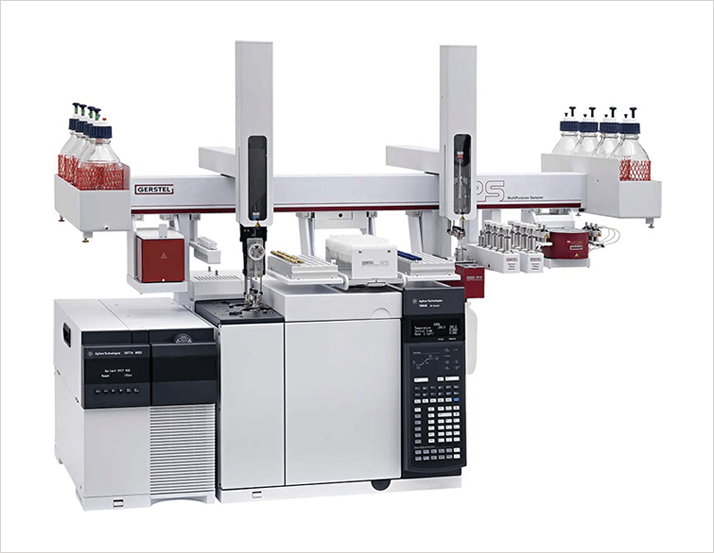Abstract
Analyzing blood serum for opioids, cocaine and metabolites is a routine task in forensic laboratories. The most commonly used methods involve several manual or partly-automated sample preparation steps such as protein precipitation, solid phase extraction, evaporation and derivatization followed by GC/MS or LC/MS determination. In this study a comprehensively automated method is compared with a validated, partly-automated routine method. Following manual protein precipitation, the automated method relies on a MultiPurpose Sampler (MPS) to perform all remaining sample preparation steps. These include solid phase extraction (SPE), evaporation of the eluate, derivatization and introduction to the GC/MS. Quantitative analysis of close to 170 serum samples, as well as more than 50 samples of other matrices like urine, different tissues and heart blood, was performed using both methods. Cocaine, benzoylecgonine, methadone, morphine, codeine, 6-monoacetylmorphine, dihydrocodeine and AN/2013/07 - 2 7-aminofl unitrazepam were determined quantitatively and the methods were found to produce equivalent analytical results even near the limits of quantification [1].

Introduction
Toxicological chromatographic analysis of biological fl uids or tissues usually requires sample preparation for cleanup and enrichment. Recently in conjunction with very sensitive and selective mass spectrometers protein precipitation alone [2] or “dilute and shoot” methods [3,4] were also used though these methods may suffer from sample dependent matrix effects that can compromise the accuracy of the results. Although the number of LC-MS/MS methods is rapidly increasing [5,6,7,8] GC-MS/(MS) is still the standard routine analysis technique in many forensic laboratories [5,9,10,11]. Solid Phase Extraction (SPE) is the most widely used extraction technique for toxicological analysis of biological fl uids and tissues [10,11,12]. Typically polypropylene cartridges with a fi xed sorbent bed (typically mixed mode cation exchange cartridges) are used. A range of methods for the analysis of opioids, cocaine and metabolites in different matrices was published. The compounds were analyzed in matrices like urine [10,13,14], whole blood, serum, plasma [6,8,10], saliva [7], hair [9] or post-mortem samples [15]. In this study a validated, partly-automated SPEGC/ MS analysis method for opioids, cocaine and metabolites was completely automated. Analysis results of both methods were compared. Automation was performed by different modules attached to a GERSTEL MultiPurpose Sampler MPS. This allowed mimicking the manual workfl ow of sample dilution, SPE, evaporation, derivatization and sample injection.
Experimental
Instrumentation. The system employed for automation of the sample preparation is based on a MultiPurpose Sampler (MPS, GERSTEL). It was confi gured with two syringes, a 2.5 mL syringe with gas supply for the sample preparation steps and a 10 μL syringe used for sample injection into a Cooled Injection System CIS 4 (GERSTEL) coupled to a 7890 GC/5975 MSD (Agilent Technologies). The MPS was equipped with modules for solid phase extraction (SPE), for evaporation of solvents under controlled vacuum and temperature (MultiPosition eVAPoration station, mVAP), for shaking under controlled temperature conditions (Agitator) and for supplying large volumes of solvents (Solvent Filling Station 2, SFS 2, all GERSTEL). The complete system is shown in figure 1.
 Figure 1. Setup used for the automated analysis of blood serum for THC and metabolites. Dual Head MultiPurpose Sampler (MPS) equipped with solvent bottle holder, agitator, standard wash station, trays for eluate vials, SPE cartridges and samples, SPE module, two solvent fi lling stations (SFS), MultiPosition eVAPoration station (mVAP) and solvent bottle holder (from left to right).
Figure 1. Setup used for the automated analysis of blood serum for THC and metabolites. Dual Head MultiPurpose Sampler (MPS) equipped with solvent bottle holder, agitator, standard wash station, trays for eluate vials, SPE cartridges and samples, SPE module, two solvent fi lling stations (SFS), MultiPosition eVAPoration station (mVAP) and solvent bottle holder (from left to right).




